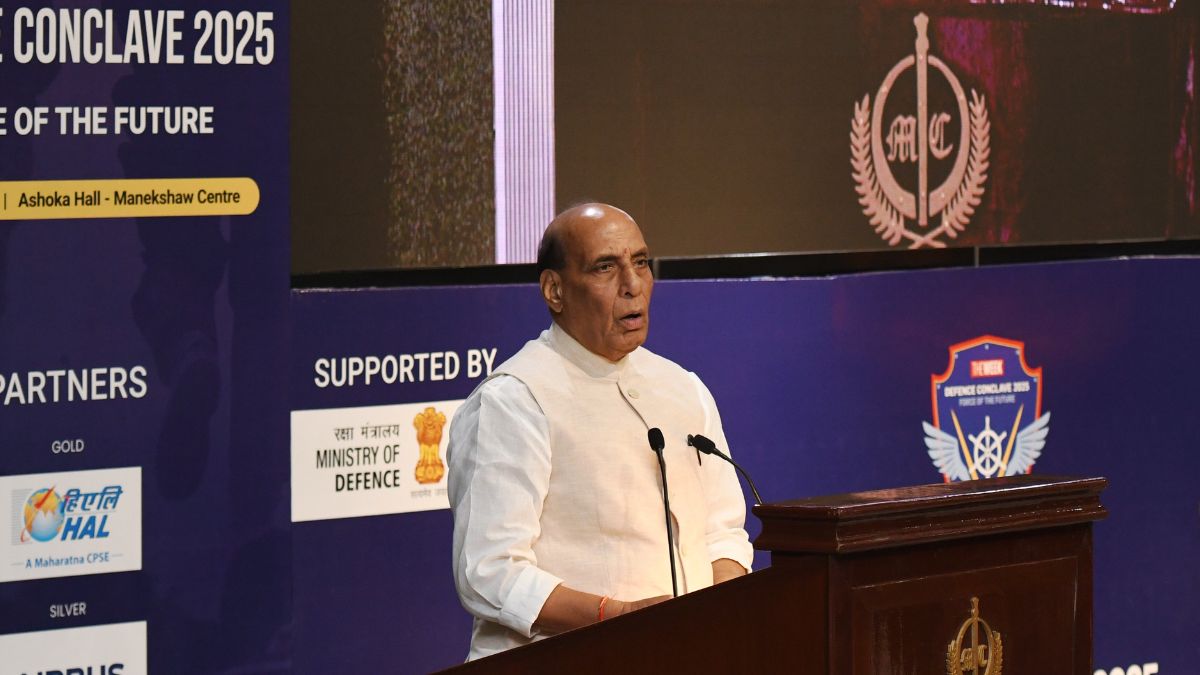From defence reforms to peace-keeping: 5 takeaways from Rajnath Singh’s speech at THE WEEK Defence Conclave 2025
 Union Defence Minister Rajnath Singh addresses the audience at ‘THE WEEK Defence Conclave 2025: Force of the Future’ in New Delhi | Sanjay Ahlawat
Union Defence Minister Rajnath Singh addresses the audience at ‘THE WEEK Defence Conclave 2025: Force of the Future’ in New Delhi | Sanjay Ahlawat
During the inaugural session of THE WEEK Defence Conclave 2025, Union Defence Minister Rajnath Singh highlighted the mindset change that the Modi government has brought to the defence sector, making it future-ready. He reflected on the challenges inherited by his government and the far-reaching reforms carried out in the last 11 years, which are aimed at building a self-reliant, export-ready, and future-ready defence apparatus.
Singh expressed confidence that India’s defence strength will not only help it become a developed nation but also enable it to emerge as a top-tier global military power in the years to come. His only concern was the delay in the development of the aero engine.
Here are the five takeaways from Defence Minister Rajnath Singh's speech at the inaugural session of THE WEEK Defence Conclave 2025.
1. A shift in mindset
Singh highlighted that one of the government’s key initiatives was to change the national mindset towards defence—from dependence on imports to faith in domestic capability.
Unlike in the past, when self-reliance was not even a distant goal, the present government has made it central to defence strategy. The previous approach of "import if needed" has been replaced with an assertive 'Make in India, Make for the World' model.
India is now building its own systems, not only for internal security but also for export to friendly nations.
2. Rise in domestic defence production and exports
India’s domestic defence production has grown from approximately ₹40,000 crore in 2014 to over ₹1.27 lakh crore in 2024. The target is ₹1.60 lakh crore this year and ₹3 lakh crore by 2029, reflecting a consistent upward trajectory.
Defence exports have surged from ₹686 crore in 2013–14 to ₹23,622 crore in 2024–25. Indian-made defence products now reach nearly 100 countries, with a target of ₹30,000 crore in 2025 and ₹50,000 crore by 2029.
Global defence manufacturers are moving from the fragile "Just-in-Time" model to a more secure "Just-in-Case" model.
India’s Make in India programme positions it as a reliable hub in global defence supply chains.
The Ministry has also released positive indigenisation lists, covering over 5,500 items including key systems, spares, and subsystems. These will be manufactured exclusively in India, boosting the local ecosystem.
Initiatives like iDEX, iDEX Prime, and the newly launched ADITI scheme are driving innovation by offering funding up to ₹25 crore for startups developing futuristic defence tech. Over ₹2,400 crore has been earmarked for purchases from startups/MSMEs.
3. Defence reforms and institutional changes
Key reforms such as the creation of the Chief of Defence Staff (CDS) and the planned rollout of theatre commands aim to enhance jointness, integration, and operational efficiency among the tri-services. The increased participation of women in all three wings of the armed forces—from sea patrols to mountain posts—was hailed as a sign of inclusive modernisation and strength.
The Defence Ministry has declared 2025 as the 'Year of Reforms', marking its commitment to continuous transformation—both in capability building and institutional processes—to future-proof India’s security.
The conversion of 200-year-old Ordnance Factories into corporate entities marked a major structural reform. This has resulted in improved efficiency, greater accountability, and profitability, without compromising employee interests or national security.
4. Aero Engine capability: Still a strategic gap
Singh acknowledged that aero engine manufacturing remains a critical gap, but was hopeful that despite the delay the targets will be met.
He stated that progress under the Kaveri engine project has been promising. India is actively engaging with global firms like Safran, Rolls-Royce, and GE for technology transfer (ToT) to manufacture engines for Tejas and 5th-generation fighter jets.
5. From war-making to peace-keeping
Rajnath Singh clarified that the government’s defence emphasis is not to wage war but to ensure peace through strength. Future wars will be marked by unpredictability, non-state actors, cyber threats, and narrative control.
India is strengthening its forces through holistic capacity building and is ready to face emerging multi-domain challenges.
India is making notable strides in AI, cyber defence, hypersonics, drones, and space-based warfare. These developments are crucial to counter modern asymmetric threats and prepare for multi-domain conflicts.
Defence